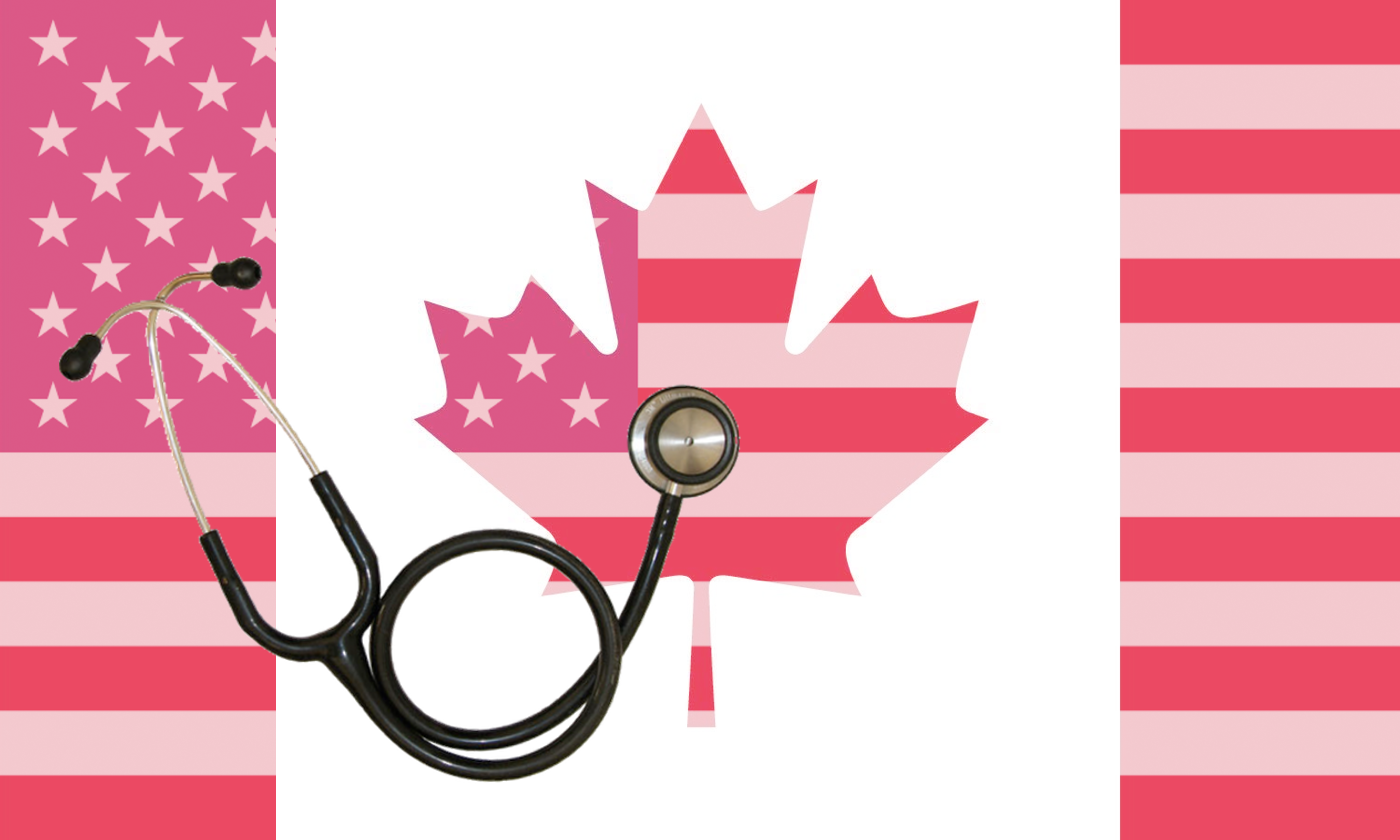Canada is rightfully considered a country with a high quality of life. The average life expectancy now exceeds 82 years, and people here consider themselves healthy throughout their lives. Obviously, healthcare in Canada does its job, while being not as expensive as in the US, Switzerland, or Germany. The average American pays $2,497 per year in insurance and administrative expenses, while the Canadian only pays $551.

Canadian health care is partially funded by the government and works on the principle of accessibility for all groups of the population. This universal, publicly funded system is known as Medicare. Unified health insurance allows one to receive medical care in one’s province for free or with minimal surcharges. At the same time, part of the money for the implementation of the program comes from contributions of residents, and the distribution of funds, medicines and personnel is carried out at the local level. The Canadian healthcare system is a source of national pride and a model of universal health coverage. One of its foundations is access to health care based on need rather than paying capacity. As of 2020, Canada ranks 24th in the World Health System Rankings. Despite its position being relatively low, 89% of Canadians reported in a survey that they consider themselves perfectly healthy, which is a great indicator.
Health insurance in Canada
Canada has government health insurance, funded by tax revenues. It is organized on a regional basis, with each province adopting its own rules. Access, quality, and satisfaction with healthcare in Canada are relatively high and costs are well controlled. The Canadian model is based on the recognition of market boundaries in the distribution of healthcare. Canada has a national health insurance scheme called NHI (a public health insurance scheme that covers the entire population with a good package of health benefits). Health insurance is universal. The NHI is funded by general taxes through a single-payer system (only one third party payer is responsible for paying for health care services). Consumer copayments are insignificant and the choice of doctors is unlimited. The provision of medical services is private. Physicians receive payments at a negotiated rate for services and hospital stays, as well as payments to the global budget (a method used by third-party payers to control healthcare costs by setting general spending limits for health care services over a period of time). The health-care system in Canada is known as Medicare. It should not be confused with Medicare for Seniors in the United States.
Health cards
Canadian citizens, as well as persons permanently residing in Canada, are eligible for Health Insurance Card (HIC). It was introduced under the 1984 Federal Canada Health Act. Provinces and territories independently develop their healthcare programs and organize card issuance to their residents. The cards can only be used within the home region. Depending on the province the list of free medical services and the amount of mandatory fees may change. Canadians will not be denied treatment in other provinces; however, they will have to pay. Exceptions are emergencies and life-threatening situations. In these cases, even illegal immigrants receive medical help free of charge.
Medicare covers about 70% of medical expenses, including various tests and examinations. The rest is paid by the patient or through a private health insurance program. More than half of the population additionally takes out a private health insurance policy, which provides for more extensive insurance coverage. The following risks are covered under the Canadian public health insurance program:
- Outpatient care;
- Hospital treatment;
- Emergency surgery;
- Laboratory tests with a referral from a general practitioner.
Not covered by Medicare:
- Ambulance services;
- Home health care;
- Medications;
- Dental care;
- Services in the field of reproductive medicine;
- Non-traditional methods of treatment (alternative medicine);
- Ophthalmologist services.
Dental services can be provided free of charge only in an emergency when an urgent operation is needed (e.g. tooth extraction).
Canadian drug price regulation
The Patented Medicine Prices Review Board (PMPRB) sets maximum prices for prescription medicines by assessing each medicine’s therapeutic value. Changes to be implemented in January 2021 are aimed to impose even stricter price control over patented drugs. This is of course an obvious advantage for Canadian buyers compared to their American neighbors.
However, some researchers claim that tight price regulation reduces the number of new medicines launching in the country, as well as investment in R&D and access to innovative drugs. Such correlation is denied by the PMPRB director. Nonetheless, the US government continues to present the negative impact of price control as one of its main arguments not to intervene in price setting.
Buying medicines in Canada
Most brand-name drugs provide the same effect as their “no name” counterparts, which are called generic medicines. The difference in price can range from 20% to 800%. For example, the sedative drug Valium costs $21.79 in the US, while a similar drug, Diazepam, here costs $7.99. Keflex (a medicine for bacterial infections) costs $44.09, and its generic counterpart Cephalexin costs $21.79. The relaxation drug Inderal costs $19.99, and its counterpart Propranolol is only $4.99. Flexeril muscle pain medicine is available for $25.79, and its counterpart Cyclobenzaprine costs $20.49.
Most of the brand-name drugs sold in Canadian pharmacies have a cheaper equivalent. If a doctor has prescribed an expensive brand-name medicine, you may ask the pharmacist for a cheaper alternative. In theory, pharmacies only sell the drugs indicated in the prescription, but on some occasions, they can be incredibly sensible. Also, feel free to ask your doctor if he or she has the prescribed medication for you, as pharmaceutical companies often supply doctors with free samples of drugs to advertise their product. The policy of medical care depends on the state and can vary greatly.
For a long course of treatment, it is recommended to purchase medicines in large packages, which allow saving money. For example, a pack of 120 aspirin tablets costs $19.82, and a pack of 50 aspirin is $8.79. Do not forget to count the number of tablets and compare it with that indicated on the package. Also, note that there are discounts for seniors when purchasing drugs from pharmacies.
Just like with food products, different drugstores sell the same medicines at different prices. Drug Marts have the highest prices, stores like Saveway or London Drugs — slightly lower, and the Super Store offers the best deals.
Private health insurance programs in Canada
Canada has a large selection of local and international health insurance providers. Many locals and ex-pats living in Canada additionally take out private health insurance to cover risks such as psychiatric/psychological treatment;
- Speech therapy;
- Non-traditional methods of treatment (alternative medicine);
- Medical evacuation;
- Repatriation;
- Dental care;
- Ophthalmic services.
Each private insurance company, as a rule, offers individual insurance conditions and various programs that differ in the insurance limit, the range of risks covered, and the duration of the policy. You can apply for a private health insurance policy in Canada directly from an insurance company or an insurance broker. The cost of the policy varies depending on the province in which the insured lives, as well as on the chosen insurance program. On average, the annual cost of health insurance for a family of three is around $3,000-$3,500.
Features of medical care provision
Medicine in Canada is based on general practitioners. They are the link between the patient and further treatment strategy. There are few usual state polyclinics in the country. These are found only in some provinces. Mostly, people are treated in private clinics. All expenses for the treatment of residents and those who have insurance are reimbursed from the state budget. However, hospitals in Canada are not as ideal as they seem. There are queues and coupons for making an appointment with a doctor, for examination, and surgery.
Pregnancy and childbirth in Canada
The costs of pregnancy and childbirth are covered by the Canadian government insurance program. Individuals who do not have access to the country’s health care system can pay for the services themselves, or take out a private health insurance policy that covers the costs of pregnancy and childbirth. Pregnancy diagnostics in Canada are carried out using tests, an extensive selection of which is presented in pharmacies in the country, as well as using laboratory tests during a visit to a gynecologist. Abortion is legal throughout Canada. However, each province has a different gestational age at which surgery is allowed. As a rule, medical termination of pregnancy is carried out for up to 9–12 weeks, surgical up to 23 weeks.
Dentistry in Canada
In case of severe toothache, it is possible to go to the emergency department of a nearby hospital. The patient will certainly be received and referred to the dentist on duty. However, the tooth in question will be simply extracted for providing emergency assistance. For dental conservation treatment contact your dentist and do it as early as possible. The cost of treating one tooth is about $50-100. Complex or serious cases can cost more, up to $500-600. The price range for a single dental implant in Canada starts at $1,000 and may go well above $5,000.
When applying for a permanent job (not under a contract), the employee is offered a benefits package in addition to the basic salary. Most often, this is medical insurance for dentist services for the whole family, usually not exceeding $2,000-$3,000 per year.
For schoolchildren whose parents cannot afford to pay for the dentist’s services, there is a special program under which they are treated by dentists contracted by Education Canada. This, of course, is a significant help to people who have not yet settled in the country, but the quality of treatment by such doctors is noticeably inferior to the quality of treatment by paid dentists.
In larger cities, it is possible to receive dental treatment at reduced prices using the services of immigrant dentists, who are unable to practice legally until they pass the exam and get their diploma confirmed. This procedure usually takes two to three years, and sometimes more. During this time, immigrant dentists begin to practice illegally. The quality of their services is usually not inferior to the quality of certified Canadian doctors, and the prices are much lower (dental treatment will cost about $30, prosthetics about $100).
Tips for visitors
Although medical care is free for Canadian residents, anyone who is not a Canadian citizen and does not have health insurance must pay for treatment in case of illness. The cost of treatment in Canadian hospitals is relatively high. One day in a local hospital costs about $4,000. A simple surgery will cost $20,000. Besides, the patient has to pay for X-rays, medications, procedures, care, etc. The cost of visiting a general therapist varies from $100 to $250.
How much does commercial health insurance cost?
The minimum health insurance coverage is $5,000, the maximum is $100,000. Prices naturally vary according to age. The price range starts from $ 1.3 per day with insurance for $5,000 to $5 per day with insurance of $100,000.
Not all insurance plans cover illness that emerged in Canada, let alone ailments that existed before the arrival. Most plans only cover unforeseen accidents. Prices for such insurances are relatively low. A good plan should include not only the risk of unexpected fractures but also the most common illnesses: an attack of diabetes, worsening ulcers, pneumonia, etc. A very good insurance plan also should cover existing ailments. However, there are limitations here. For example, a postponed operation six months before arrival may cause complications and imminent medical expenses that will not be covered. Chronic diseases under supervision in case of an attack will be covered by insurance.
Comparison of the US and Canadian healthcare systems
Comparing health status and health system utilization in the United States and Canada continues to be of great interest in both countries. The two countries are separated by an open border. They overlap in various ways in several policy areas, including how health services are financed, organized, and delivered. The most notable differences between the two countries are the role of private health insurance and the level of spending. Canadians have universal access to publicly funded health care services, mainly doctors and hospital services. Most US citizens require private insurance to cover their health care costs: government insurance is available for the poor (Medicaid) and those over sixty-five (Medicare).
The United States spends more on health care than Canada, measured both on a per capita basis and as a percentage of gross domestic product. However, in the United States, more funds come from private sector spending. A joint survey of health status in Canada and the United States showed that health status is relatively similar in the two countries, but there are differences in income levels. Americans in the poorest quintile income are likely to have poorer health than their Canadian counterparts. There were no differences between the rich in these countries. In general, Canadians’ access to services was more like insured Americans and had fewer unmet needs overall. Despite the higher level of health care spending in the United States, people in the two countries have the same health status and access to health care, although the United States has greater inequalities. A survey from two countries shows that insured Americans and Canadians have much in common, while uninsured Americans lag behind Canadians.
In health care reform discussions, the Canadian system is often viewed as a possible model for the United States. The health systems of the two countries are very different. Canada has a single-payer system, mostly publicly funded, while the US has a multi-payer powerful private system. However, these countries have a similar culture, so it is assumed that the United States will be able to accept the Canadian system. Much of the appeal of the Canadian system is that it appears to do more for less. Canada provides universal access to health care for its citizens, while nearly one in five non-elderly Americans are uninsured. Canada spends far less of its GDP on healthcare (10.4 versus 16% in the US), which still performs better than the US on two commonly cited health performance metrics: infant mortality rate and life expectancy.



